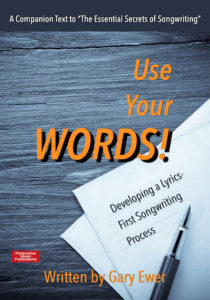In theory, there shouldn’t be a lot of difference between a melody that’s meant to be sung and one that’s meant to be played. Particularly in the pop genres, both kinds of melodies will usually display the following characteristics:
- The melody will usually move mainly by step (i.e., adjacent notes in a scale) with occasional leaps.
- The melody will often have a climactic high point somewhere.
- The notes of the melody, particularly the notes that happen on beats (as opposed to between beats), will be supported by the chord of the moment.
- A good melody typically makes good use of repetition, both exact and approximate.
And those characteristics tend to be present in melodies regardless of whether the tune is meant to be played or sung. It’s why you can usually take a vocal melody and play it, which often happens within the same song: The Byrds’ version of “Turn! Turn! Turn!”
 Trying to get a handle on writing song lyrics? Discover the benefits of making a lyrics-first method your new go-to process with”Use Your Words! Developing a Lyrics-First Songwriting Process. It’s FREE right now when you purchase the 10-eBook Bundle.
Trying to get a handle on writing song lyrics? Discover the benefits of making a lyrics-first method your new go-to process with”Use Your Words! Developing a Lyrics-First Songwriting Process. It’s FREE right now when you purchase the 10-eBook Bundle.
Having said that, there are noticeable differences between melodies that are primarily meant to be sung, and those that are primarily meant to be played. I’m not really considering the example of the improvised instrumental solo, which we know is considerably different from a sung melody. The opening guitar riff of Rush’s “Spirit of Radio” would be impossible (or comically difficult) to sing.
For a classic rock example of the kind of melody I’m talking about, consider the flute solo melody in The Mama’s and the Papa’s’ “California Dreamin’” (John & Michelle Phillips).
It has all the basic characteristics listed above, but in addition you’ll notice that there’s 1) a wandering quality and 2) a freer approach to rhythm that would make it a bit hard to put words to.
Also, most instruments have a kind of “flexibility” that allows them to move from one octave to another and back again with considerably more ease than with the voice. So a solo that jumps around from low to high octaves and back again are expected in instrumental melodies, and don’t require a lot of effort. Jumping octaves in vocal melodies requires a high level of technique, and often won’t work well.
If Vocal Melodies Are Hard to Write
If you find vocal melodies hard to write, you might consider this: you may find yourself better at writing instrumental melodies. There’s no particular need for an instrumental melody to be much different from what you might write for the voice,.
The benefit of writing an instrumental melody is that you can get the note/chord relationship working first without worrying about what words you might put with that melody. Once you’ve got that working well, you may find it easier to then consider lyrics as a second step.
And if you find that your notion of the melody as instrumental has caused you to write something that sounds more appropriate for guitar or keyboard than voice, do the following to fix it:
- Simplify the melodic rhythms.
- Concentrate on using more repetition as an important structural element.
- Keep the melody from wandering around too much. A melody that encompasses more than an octave becomes trickier to sing.
 Written by Gary Ewer. Follow on Twitter.
Written by Gary Ewer. Follow on Twitter.
Have a great melody, but stuck at the “how to add chords to it” stage? “How To Harmonize a Melody” shows you, step-by-step and with sound samples, how it’s done, with suggestions for chord substitutions that might work as well. It’s part of “The Essential Secrets of Songwriting” 10-eBook Bundle.











Also, you most likely want the audience to be able to sing the words along, which is, more often than not, not the case with an instrumental melody or a solo. This may explain in part why vocal melodies are often “dumbed down” versions of the instrumental lead.
One reason instrumental melodies do tend to be more “adventurous” is that when you are writing you have a very good idea of the range of the instrument and often want to make good use of it. Instruments don’t make words (with some exceptions), so you need to get the drama for the listener in other ways.
In general, no one writes for singers assuming the range of Mariah Carey, Freddie Mercury or the legendary Tim Storms, for that would really narrow the target artist. They leave it for the artist or the arranger to work in the vocal gymnastics, so the manuscript written range is generally two octaves or so, I’ve discovered.
I play EWI and I’ve been teasing a composer friend of mine that he should write the definitive concerto for EWI and orchestra. I wonder what sort of range he’d use.
Great column and thought-provoking points!